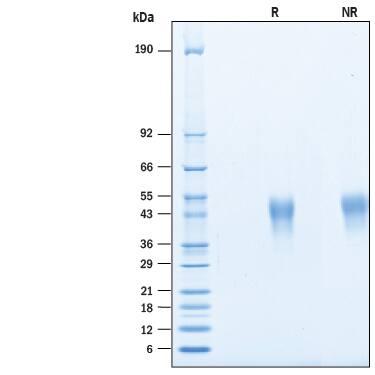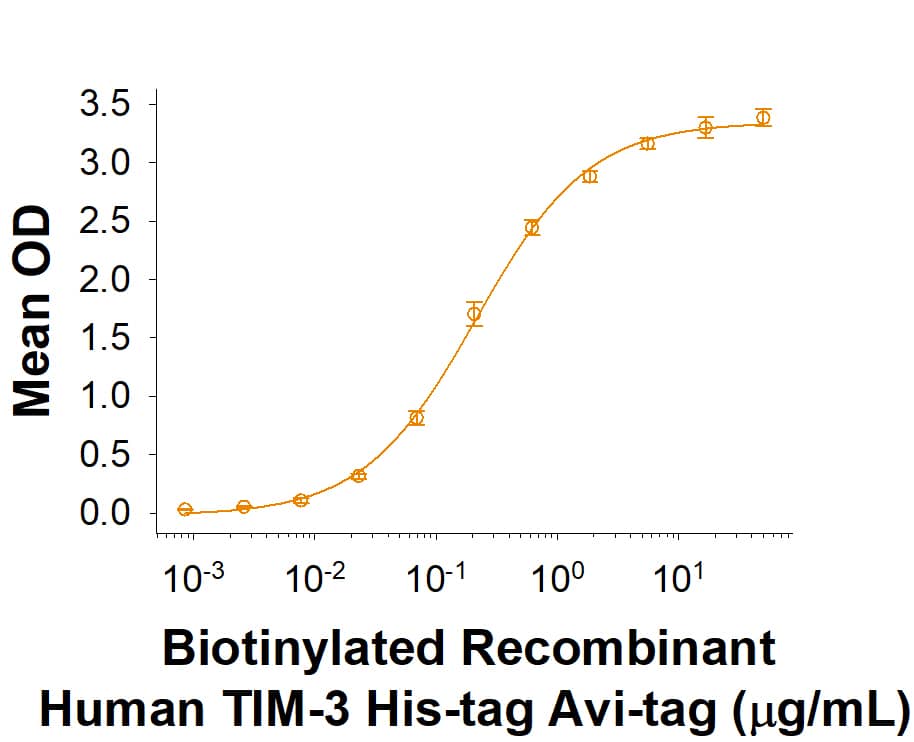Recombinant Human TIM-3 His-tag Avi-tag Protein, CF
R&D Systems, part of Bio-Techne | Catalog # AVI10241
Biotinylated

Key Product Details
Learn more about Avi-tag Biotinylated Proteins
Source
CHO
Accession #
Structure / Form
Biotinylated via Avi-tag
Conjugate
Biotin
Applications
Bioactivity
Product Specifications
Source
Chinese Hamster Ovary cell line, CHO-derived human TIM-3 protein
| Human TIM-3 (Ser22-Arg200) Accession # AAH63431.1 |
HHHHHH | Avi-tag |
| N-terminus | C-terminus |
Purity
>95%, by SDS-PAGE visualized with Silver Staining and quantitative densitometry by Coomassie® Blue Staining.
Endotoxin Level
<0.10 EU per 1 μg of the protein by the LAL method.
N-terminal Sequence Analysis
Ser22
Predicted Molecular Mass
23 kDa
SDS-PAGE
37-50 kDa, under reducing conditions
Activity
Measured by its binding ability in a functional ELISA.
When Recombinant Human Galectin‑9 (Catalog # 2045-GA) is immobilized at 1 μg/mL (100 μL/well), the concentration of Biotinylated Recombinant Human TIM‑3 His-tag Avi-tag (Catalog # AVI10241) that produces 50% of the optimal binding response is 0.1-0.8 μg/mL.
When Recombinant Human Galectin‑9 (Catalog # 2045-GA) is immobilized at 1 μg/mL (100 μL/well), the concentration of Biotinylated Recombinant Human TIM‑3 His-tag Avi-tag (Catalog # AVI10241) that produces 50% of the optimal binding response is 0.1-0.8 μg/mL.
Scientific Data Images for Recombinant Human TIM-3 His-tag Avi-tag Protein, CF
Recombinant Human TIM-3 His-tag Avi-tag Protein Binding Activity
When Recombinant Human Galectin-9 (Catalog # 2045-GA) is immobilized at 1 µg/mL, 100 µL/well, Biotinylated Recombinant Human TIM-3 His-tag Avi-tag (AVI10241) binds with an ED50 of 0.1-0.8 µg/mL.Recombinant Human TIM-3 His-tag Avi-tag Protein SDS-PAGE
2 μg/lane of Recombinant Human TIM-3 His-tag Avi-tag (Catalog # AVI10241) was resolved with SDS-PAGE under reducing (R) and non-reducing (NR) conditions and visualized by Coomassie® Blue staining, showing bands at 37-50 kDa.Formulation, Preparation and Storage
AVI10241
| Formulation | Lyophilized from a 0.2 μm filtered solution in PBS with Trehalose. |
| Reconstitution | Reconstitute at 200 μg/mL in PBS. |
| Shipping | The product is shipped at ambient temperature. Upon receipt, store it immediately at the temperature recommended below. |
| Stability & Storage | Use a manual defrost freezer and avoid repeated freeze-thaw cycles.
|
Background: TIM-3
References
- Sakuishi, K. et al. (2011) Trends Immunol. 32:345.
- Anderson, A.C. (2012) Curr. Opin. Immunol. 24:213.
- Monney, L. et al. (2002) Nature 415:536.
- Nakayama, M. et al. (2009) Blood 113:3821.
- Anderson, A.C. et al. (2007) Science 318:1141.
- Wiener, Z. et al. (2007) J. Invest. Dermatol. 127:906.
- Chiba, S. et al. (2012) Nat. Immunol. 13:832.
- Sanchez-Fueyo, A. et al. (2003) Nat. Immunol. 4:1093.
- Ndhlovu, L.C. et al. (2012) Blood 119:3734.
- Gleason, M.K. et al. (2012) Blood 119:3064.
- Zhu, C. et al. (2005) Nat. Immunol. 6:1245.
- Sakhdari, A. et al. (2012) PLoS ONE 7:e40146.
- Sabatos, C.A. et al. (2003) Nat. Immunol. 4:1102.
- Dardalhon, V. et al. (2010) J. Immunol. 185:1383.
Long Name
T Cell Immunoglobulin Mucin-3
Alternate Names
CD366, HAVcr-2, HAVCR2, KIM-3, SPTCL, TIM3, TIMD3
Entrez Gene IDs
Gene Symbol
HAVCR2
UniProt
Additional TIM-3 Products
Product Documents for Recombinant Human TIM-3 His-tag Avi-tag Protein, CF
Product Specific Notices for Recombinant Human TIM-3 His-tag Avi-tag Protein, CF
For research use only
